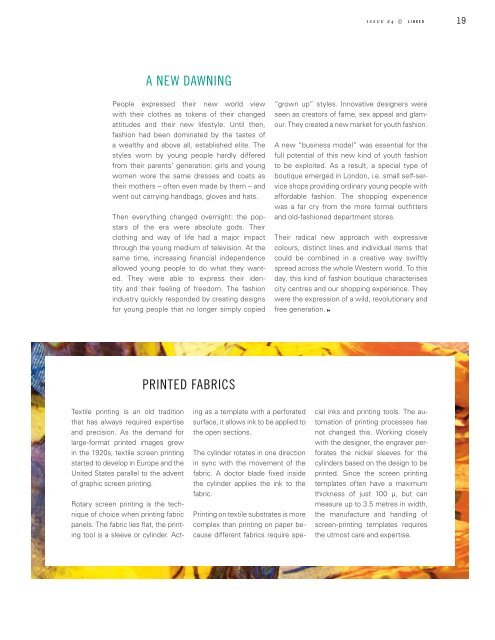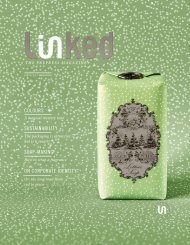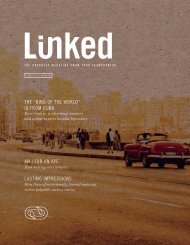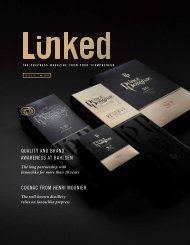Create successful ePaper yourself
Turn your PDF publications into a flip-book with our unique Google optimized e-Paper software.
issue #4 ©<br />
l i n k e d<br />
19<br />
A new dawning<br />
People expressed their new world view<br />
with their clothes as tokens of their changed<br />
attitudes and their new lifestyle. Until then,<br />
fashion had been dominated by the tastes of<br />
a wealthy and above all, established elite. The<br />
styles worn by young people hardly differed<br />
from their parents’ generation: girls and young<br />
women wore the same dresses and coats as<br />
their mothers – often even made by them – and<br />
went out carrying handbags, gloves and hats.<br />
Then everything changed overnight: the popstars<br />
of the era were absolute gods. Their<br />
clothing and way of life had a major impact<br />
through the young medium of television. At the<br />
same time, increasing financial independence<br />
allowed young people to do what they wanted.<br />
They were able to express their identity<br />
and their feeling of freedom. The fashion<br />
industry quickly responded by creating designs<br />
for young people that no longer simply copied<br />
“grown up” styles. Innovative designers were<br />
seen as creators of fame, sex appeal and glamour.<br />
They created a new market for youth fashion.<br />
A new “business model” was essential for the<br />
full potential of this new kind of youth fashion<br />
to be exploited. As a result, a special type of<br />
boutique emerged in London, i.e. small self-service<br />
shops providing ordinary young people with<br />
affordable fashion. The shopping experience<br />
was a far cry from the more formal outfitters<br />
and old-fashioned department stores.<br />
Their radical new approach with expressive<br />
colours, distinct lines and individual items that<br />
could be combined in a creative way swiftly<br />
spread across the whole Western world. To this<br />
day, this kind of fashion boutique characterises<br />
city centres and our shopping experience. They<br />
were the expression of a wild, revolutionary and<br />
free generation.<br />
Printed fabrics<br />
Textile printing is an old tradition<br />
that has always required expertise<br />
and precision. As the demand for<br />
large-format printed images grew<br />
in the 1920s, textile screen printing<br />
started to develop in Europe and the<br />
United States parallel to the advent<br />
of graphic screen printing.<br />
Rotary screen printing is the technique<br />
of choice when printing fabric<br />
panels. The fabric lies flat, the printing<br />
tool is a sleeve or cylinder. Acting<br />
as a template with a perforated<br />
surface, it allows ink to be applied to<br />
the open sections.<br />
The cylinder rotates in one direction<br />
in sync with the movement of the<br />
fabric. A doctor blade fixed inside<br />
the cylinder applies the ink to the<br />
fabric.<br />
Printing on textile substrates is more<br />
complex than printing on paper because<br />
different fabrics require special<br />
inks and printing tools. The automation<br />
of printing processes has<br />
not changed this. Working closely<br />
with the designer, the engraver perforates<br />
the nickel sleeves for the<br />
cylinders based on the design to be<br />
printed. Since the screen printing<br />
templates often have a maximum<br />
thickness of just 100 µ, but can<br />
measure up to 3.5 metres in width,<br />
the manufacture and handling of<br />
screen-printing templates requires<br />
the utmost care and expertise.









